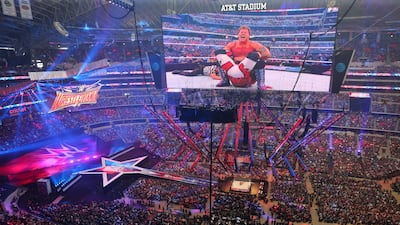Musical acts, celebrity sightings and travel packages: how exactly did Wrestlemania become the pop culture spectacle it has become today?
For wrestling fans, gone are the days of simple matches and a single four-hour pay-per-view show. Today, musical acts, celebrity guest appearances and even special hosts now make up Wrestlemania.
The former one day event is now spread over the course of a weekend, and even has a chosen host city (similar to the Super Bowl).
There's almost as much at stake in being a chosen city for the wrestling world's biggest event too; Forbes estimates the extravaganza can generate upwards to $100+ million for its economy.
But for wrestling fans, Wrestlemania serves as both an opening and closing for the WWE in the sense that it ties up a year's worth of storylines while also helping position itself for the future.
The history of Wrestlemania
The first Wrestlemania came to fruition in 1985 at Madison Square Garden in New York City, as the brainchild of Vince McMahon. Looking to create something unique, McMahon wanted something that was more than just wrestling.
From the get-go, it seemed this would be something special.
Celebrities were on the bill immediately, with actor Mr T teaming up with Hulk Hogan, to take on Roddy Piper and Paul Orndorff in a tag-team match in the inaugural Wrestlemania main event. The event also featured super-star musicians Cyndi Lauper and Liberace, as well as boxer Muhammad Ali.
Considered a gamble by the WWE at the time, Wrestlemania proved so successful, it kicked off what has become an annual tradition ever since.
The celebrity endorsements
Looking to take wrestling mainstream, the WWE has invited bigger and bigger names to the event as it has progressed.
Kim Kardashian was the guest hostess for Wrestlemania 24, boxer Mike Tyson was a ringside enforcer for the main event at Wrestlemania 14, and actor Mickey Rourke also stepped inside the ring at Wrestlemania 25.
It's also become a way for the WWE to reach new fans, depending on what celebrities they choose to target.
Continuing the tradition, Saturday Night Live's Colin Jost and Michael Che stepped into the ring for this year's Wrestlemania, and competed in the Andre The Giant Memorial Battle Royal.
The musical performances
As the event has grown bigger and bigger, with more matches being added (further extending an already lengthy running time), musical performances are just another way to break up all the wrestling. Well that, and proving a drawcard in their own right.
In the past, the WWE has invited musicians to perform the entrances for its wrestlers (such as Nina Strauss for Shinsuke Nakamura, Living Colour for CM Punk and Snoop Dogg for Sasha Banks).
There are also often standalone musical performances. At Wrestlemania 28, Flo Rida performed his hit song Wild Ones, while P Diddy and Skyler Grey performed Coming Home to kick off Wrestlemania 29, perhaps helping to evoke the notion that this is now about more than just wrestling.
More fan involvement
As we've said, Wrestlemania is no longer just a single event, as there's now an entire weekend dedicated to it. WWE has lined up its NXT special (a spin-off brand from the WWE) as well as its Hall of Fame ceremony into the line-up, to offer more for fans.
Perhaps one of the most exciting things for WWE fans is Wrestlemania Axxcess, which has its sessions interspersed throughout the weekend. Here, fans can attend meet-and-greets with their favourite wrestlers, and pick up merchandise such as t-shirts or replica title belts. There are also live matches and interactive stands – such as the one that allows fan to re-create their favourite wrestler's entrances, or one where fans can commentate a match.
With the growing fanbase and the growing talent on the roster, it's a nice opportunity for fans and superstars alike to interact with one another.
"It's just such an amazing experience and it grows larger and larger every year," says WWE star Lio Rush, who was at Wrestlemania by the side of Bobby Lashley (they have an alliance. It's a long story). "It's a one-of-a-kind event and you don't see it anywhere else, especially with crowd interaction. I'm sure it means so much to the fans."


